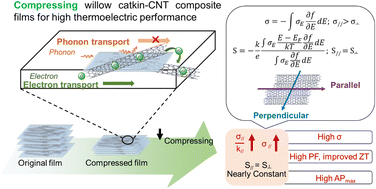Green biopolymer-CNT films exhibit high thermoelectric power factor and electrical conductivity for low temperature heat energy harvesting†
Abstract
Exploring high performance flexible thermoelectric materials with biopolymer hybrids fulfills the concept of green energy produced by green materials. The power generation ability of a thermoelectric (TE) device is strongly related to the thermoelectric power factor and the electrical conductivity of TE materials. However, it is very challenging to have a high power factor of >2000 μW m−1 K−2 together with a high electrical conductivity of >1000 S cm−1 in biopolymer-based TE materials since biopolymers are typically non-conductive. In this work, we reported a high power factor of >2500 μW m−1 K−2 with a high electrical conductivity of about 7450 S cm−1 which was achieved in biopolymer and carbon nanotube (CNT) hybrids at a relatively low CNT concentration of 33.3 wt%. This power factor is comparable to or even larger than that of many state-of-the-art only CNT films/fibers, and even inorganic TE films, such as Bi2Te3 films. The reason for the high power factor accompanied by a high electrical conductivity is attributed to the anisotropic electrical conductivity and isotropic Seebeck coefficient of the one-dimensional CNTs. Besides, the flexible films were pretty stable after being bent 10000 times, or washed 220 times, or wiped 5000 times. Such flexible and green TE materials with high performance are promising for future green energy harvesting.



 Please wait while we load your content...
Please wait while we load your content...